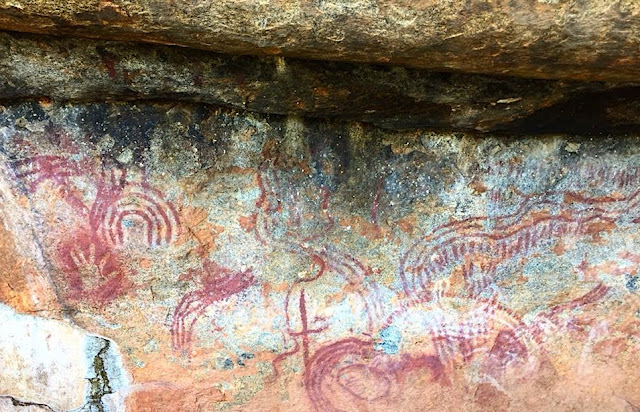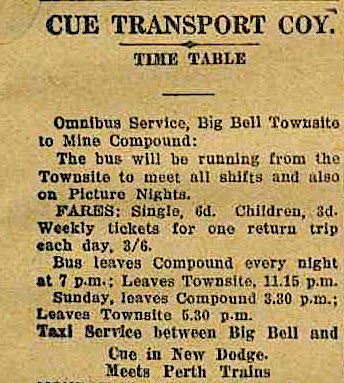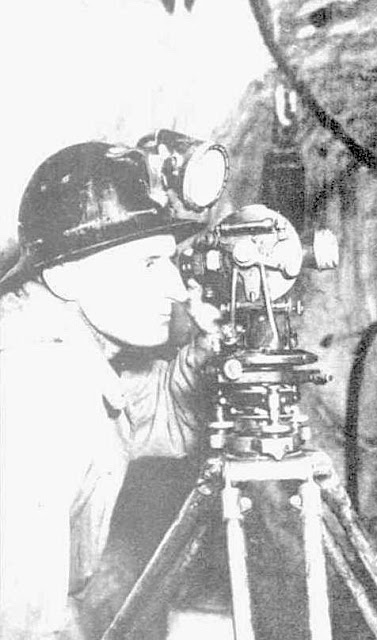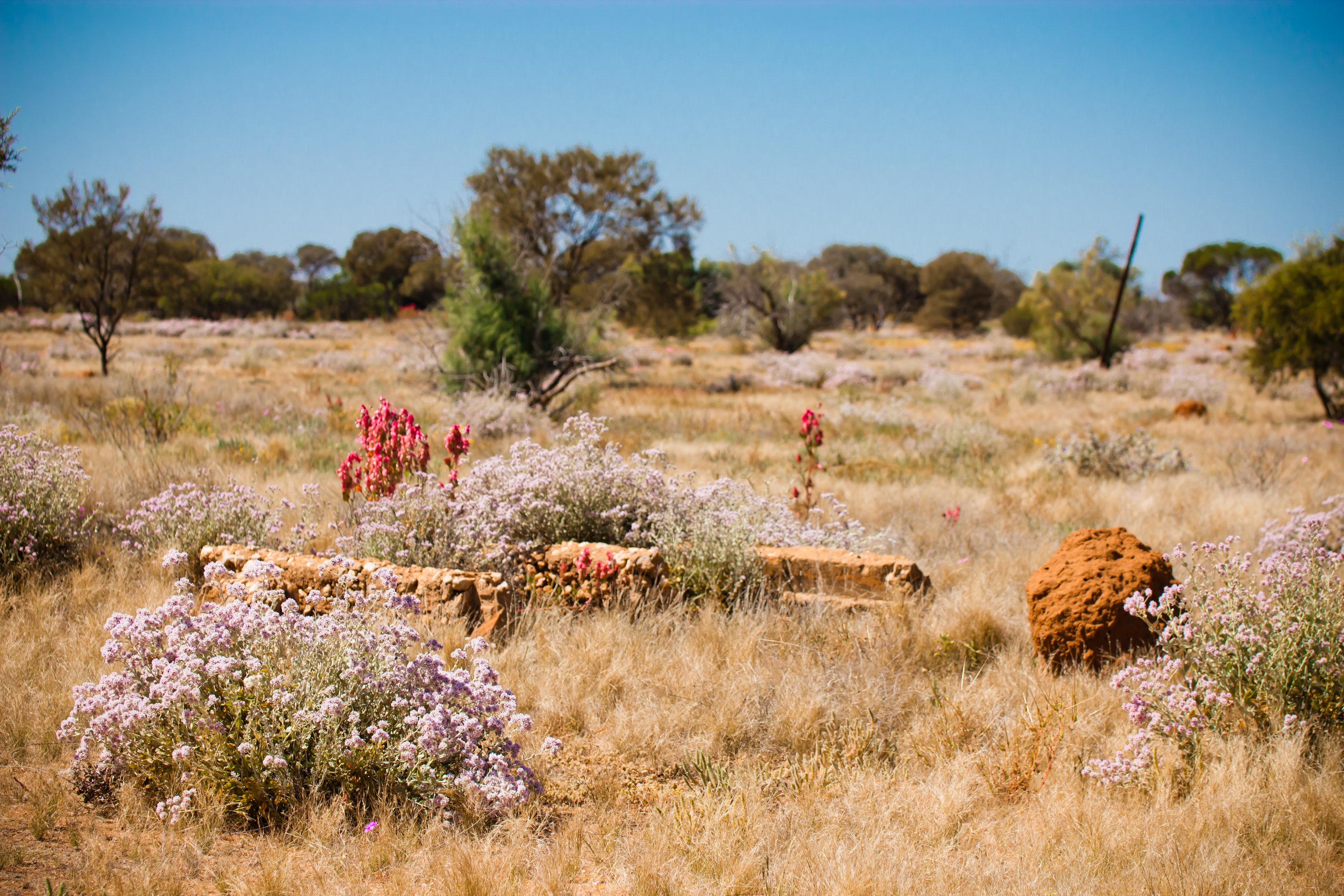The Plairhekehillerplue People
The Plairhekehillerplue Aboriginal people occupied land in the area now called Burnie, calling Emu Bay, Burduway. Research conducted in the area shows that wallaby and wombat were a principal source of food, and the Aboriginal people also created hunting grounds by the intentional use of fire, commonly known as "fire-stick farming".
The Plairhekehillerplue people were to experience devastation after the establishment at Emu Bay of the Van Diemen's Land Co. (VDL Co. ), which was formed in 1824 to provide wool for British factories.
The Plairhekehillerplue people were to experience devastation after the establishment at Emu Bay of the Van Diemen's Land Co. (VDL Co. ), which was formed in 1824 to provide wool for British factories.
Despite the fact that the VLD Co. favoured the incorporation of Aboriginal people into its activities, a culture of hostility and violence developed toward convicts and Aboriginal people. This resulted in Aboriginal retaliation and countering retribution.
The tribal system began to breakdown. Then a Tomrneginer woman named Walyer (Tarerenorerer), who had lived with a group of sealers, taught the Plairhekehillerplue to use firearms, resulting in great bloodshed. These attacks are the first recorded use of muskets by Aboriginal people.
 |
| Jemmy / Native of the Hampshire Hills / by T. Bock, Van Diemen's Land, circa 1837.SLNSW |
Walyer murdered both black and white people and her true motivations, variously interpreted, are difficult to determine. The chief protector of Aborigines, GA Robinson, wrote a letter about her to Colonel George Arthur:
"From several aborigines, I received information respecting an amazon named Tarerenore, alias, "Walyer", who was at the head of an aboriginal banditti. This woman speaks English, and issues her orders in a most determined manner. Several cattle belonging to the company have been speared, and several petty thefts have been committed, which I have traced to this woman. The Amazon is at war with several nations of aborigines, and many aborigines have been slain by her party. The Amazon is an athletic woman, middle aged, and is a native of the East Coast._ She has collected together the disaffected of several nations, and roams over a vastylent of country committing dire outrages."
Danish-born, Jorrgen Jorgenson, a somewhat notorious fellow, who was described by Marcus Clarke as "one of the most interesting human comets in history", arrived in Tasmania as a convict in 1826. He wrote a manuscript, Narrative of the Habits, Manners, and Customs of the Aborigines of Van Diemen 's Land, between 1837 to 1840. In his writing, Jorgenson claimed no marriage ceremonies were performed, partners agreeing only to form a connection.
"From several aborigines, I received information respecting an amazon named Tarerenore, alias, "Walyer", who was at the head of an aboriginal banditti. This woman speaks English, and issues her orders in a most determined manner. Several cattle belonging to the company have been speared, and several petty thefts have been committed, which I have traced to this woman. The Amazon is at war with several nations of aborigines, and many aborigines have been slain by her party. The Amazon is an athletic woman, middle aged, and is a native of the East Coast._ She has collected together the disaffected of several nations, and roams over a vastylent of country committing dire outrages."
Danish-born, Jorrgen Jorgenson, a somewhat notorious fellow, who was described by Marcus Clarke as "one of the most interesting human comets in history", arrived in Tasmania as a convict in 1826. He wrote a manuscript, Narrative of the Habits, Manners, and Customs of the Aborigines of Van Diemen 's Land, between 1837 to 1840. In his writing, Jorgenson claimed no marriage ceremonies were performed, partners agreeing only to form a connection.
These connections were exogamous and monogamous (in-group and out-group). He noted that "An Aboriginal female of the Port Davey Blacks proceeded seventy miles ... to seek a husband in preference to any of her own kindred or friends." Adultery was rare, and punishment for offenders severe. (Hodder, 2010)
 |
| Circular petroglyphs at Sundown Point, Tasmania |
 |
| Circular petroglyphs at Sundown Point, Tasmania |
In 1798, as Bass and Flinders circumnavigated Van Diemen's Land, they passed the Burnie area and named Round Hill Point, which overlooks the harbour at Burnie.
1825: The Van Diemen's Land Company
The VDL Co. was run by a group of rich and influential English businessmen with interests in the wool and textile industry. This company made application to Earl Bathurst, the Secretary of State for the Colonies, for acreage in Van Diemen's Land, where they could conduct industries using convict labour.
The VDL Co. was run by a group of rich and influential English businessmen with interests in the wool and textile industry. This company made application to Earl Bathurst, the Secretary of State for the Colonies, for acreage in Van Diemen's Land, where they could conduct industries using convict labour.
However, due to fears about the powerful connections and wealth of the individuals of this company, George Arthur, the lieutenant-governor of Van Diemen’s Land, granted land to the VDL Co., in the unexplored north-western corner of the island, which was "beyond the ramparts of the unknown". This land was mostly occupied, at this time, by Aboriginal people, escaped convicts and itinerant sealers.
 |
| Colonial Times and Tasmanian Advertiser (Hobart, Tas. : 1825 - 1827), Friday 4 November 1825 |
A Port Established
Emu Bay was chosen as a port to serve pastoral hinterland allotments called Surrey Hills and Hampshire Hill. The first settlers, mostly indentured employees or assigned convicts, arrived at Emu in1828; the great majority were sent off to Surrey Hills and Hampshire Hill. At this time, Emu Bay consisted of a small jetty, boat shed, company store, a few cottages, blacksmith shop and sawpits.
The attempt by the VDL Co. to raise merino sheep on the isolated, cold and wet hinterland of Tasmania's northwest was generally a disaster, as thousands of sheep died from starvation, the cold, and were killed by Aboriginal people, or Tasmanian tigers.
Emu Bay was chosen as a port to serve pastoral hinterland allotments called Surrey Hills and Hampshire Hill. The first settlers, mostly indentured employees or assigned convicts, arrived at Emu in1828; the great majority were sent off to Surrey Hills and Hampshire Hill. At this time, Emu Bay consisted of a small jetty, boat shed, company store, a few cottages, blacksmith shop and sawpits.
The attempt by the VDL Co. to raise merino sheep on the isolated, cold and wet hinterland of Tasmania's northwest was generally a disaster, as thousands of sheep died from starvation, the cold, and were killed by Aboriginal people, or Tasmanian tigers.
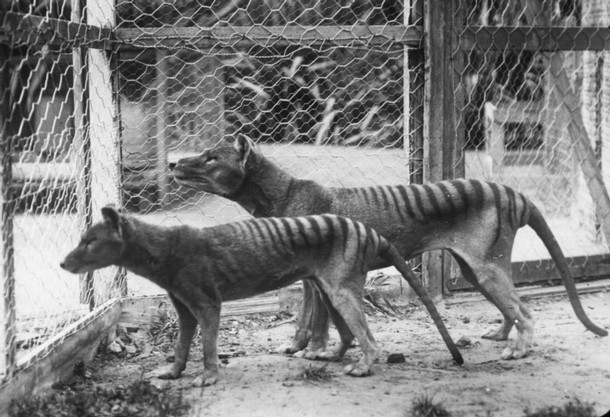 |
| Thylacine (juvenile in foreground) pair in Hobart Zoo. (before 1921) Now extinct |
Surrey and Hampshire Hills were mostly deserted by the 1830s. However, in1830, George Augustus Robertson held the first recorded religious service at Burnie.
Robinson, who was an untrained preacher, was born in England and became a "conciliator" between settlers and Aborigines, and was involved in rounding up and resettling Aboriginal people in Tasmania, in conditions, which were more akin to a prison, on Flinders Island.
The renegade Aboriginal woman, Walyer, however, would order her men to attack the settlers and she would stalk George Augustus Robinson, intending to kill him.
The renegade Aboriginal woman, Walyer, however, would order her men to attack the settlers and she would stalk George Augustus Robinson, intending to kill him.
Turbulent Times
Kickerterpoller, known in the colony as "Black Tom", or Tom Birch, was an Tasmanian Aboriginal man, who was taken away from his clan as a young boy and raised in the homes of Mrs Birch and Mrs Hodgson, as a Christian.
Governor Arthur later offered Kickerterpoller a whaleboat if he helped George Augustus Robertson make contact with Aboriginal people. It seems that he did not receive this whaleboat. Kickerterpoller died from diarrhoea on 16 May 1832, and became the first recorded Christian burial at Burnie, being buried at the back of the VDL Co. store.
1840s
In the 1840s, the settlement was renamed Burnie after William Burnie, a director of the Van Diemen's Land Company.
Tenant farm allotments at Burnie were developed during 1841–42, to encourage settlement.
When James Gibson became the manager of the VDL Co. in 1841, he ordered a survey of the town of Burnie. He directed convicts to build roads, schools and churches and he tried to convert the VDL Company into a real estate business. In 1851, all the land and asserts of the company were advertised for sale, without success, which resulted in Gibson losing his job.
1850s
The Church and The Town
In 1851 the first Anglican Church opened on the northern side of Wilmot Street. The early years of Burnie's first Anglican church were overshadowed, however, by the various scandalous actions of Reverend Zachary Pocock, who used the church's cemetery to grow crops and showed little interest in his congregation. Read here
In 1855 an article in the Launceston Examiner said that the town had:
"three Inns, one kept by Mr. Garner, is a first-rate hotel - a post-office, several stores and shops, and tradesmen of every description are on the township of Burnie. There is also an Episcopalian Church- a very neat building - and the Roman Catholics are about erecting a chapel and residence for their clergyman….”.
In 1857 the View Road Cemetery recorded its first burial. This cemetery was moved in 1952 and converted into a park.
In 1851 the first Anglican Church opened on the northern side of Wilmot Street. The early years of Burnie's first Anglican church were overshadowed, however, by the various scandalous actions of Reverend Zachary Pocock, who used the church's cemetery to grow crops and showed little interest in his congregation. Read here
In 1855 an article in the Launceston Examiner said that the town had:
"three Inns, one kept by Mr. Garner, is a first-rate hotel - a post-office, several stores and shops, and tradesmen of every description are on the township of Burnie. There is also an Episcopalian Church- a very neat building - and the Roman Catholics are about erecting a chapel and residence for their clergyman….”.
In 1857 the View Road Cemetery recorded its first burial. This cemetery was moved in 1952 and converted into a park.
1860s
In 1868 Burnie had a population of 150.
A Primitive Methodist church was built in Mount Street in 1869 and a second church was built alongside the earlier church in 1891.
1870s
Trains and Mining
Trains and Mining
When tin deposits were found at Mount Bischoff in 1871, a tramway from Waratah to Emu Bay was constructed by a subsidiary of the VDL Co., which was replaced by a railway in 1884. Emu Bay Railway opened in 1897.
Under new directorship, the VDL Co. established the company’s headquarters at Burnie in 1875, and the company expanded in the region, continuing to breed cattle and sheep.
In 1878 the production of bricks began at Captain William Jones’ Uplands Farm, on Cooee Creek.
1880s
In the 1880s, Burnie was transformed by the tin deposits found at Mount Bischoff, as Burnie became the main port for Waratah, extending further south to Zeehan in 1900.
 |
| General view of Burnie by William Pousty, TAS, no date, Tasmanian Archives and State Library (Commons) |
A Wesleyan Methodist Church was built in Cattley Street in 1894.
1900s
In 1900 Burnie had a population of more than 1500 and a new wharf was completed in the following year and named Jones Pier in honour of Captain William Jones, a successful businessman.
In 1900 Burnie had a population of more than 1500 and a new wharf was completed in the following year and named Jones Pier in honour of Captain William Jones, a successful businessman.
In 1900, the Cattley Street church, along with the Free Methodist Church on Mount Street were sold, and have been used for various purposes. Read here
 |
| View of Burnie, Tasmania - 1905, Aussie~mobs |
 |
| Burnie, Tasmania - early 1900s, Aussie~mobs |
 |
| Burnie, Tasmania - 1906 |
 |
| The breakwater at Burnie, TAS, Australasian (Melbourne, Vic. : 1864 - 1946), Saturday 3 March 1906 |
 |
| A pack track built to allow horse and foot traffic to travel from Emu Bay to Mount Bischoff, Australasian (Melbourne, Vic. : 1864 - 1946), Saturday 19 May 1906 |
 |
| West Beach, Burnie, Tasmania - circa 1914, Aussie Mobs |
_(13415645644).jpg) |
| Burnie, Tasmania, circa 1919 Tasmanian Archive and Heritage Office |
_(13415393913).jpg) |
| Burnie, Tasmania, circa 1919 Tasmanian Archive and Heritage Office |
_(13415286245).jpg) |
| Burnie, Tasmania, circa 1919, Tasmanian Archive and Heritage Office |
 |
| Advertisement for Wilfred H. Riggs, Marine Terrace, Burnie, Tasmania - 1908 |
 |
| West Beach, Burnie, Tasmania - circa 1914, Aussie Mobs |
WWI
NEVER TO RETURN 57 FALLEN BURNIE SOLDIERS.
1930s
Burnie had a population of about 4,000 in 1937.
In 1938 Associated Pulp and Paper Mills Ltd. opened using the timber resources from around Burnie to make paper. Burnie experienced a period of economic growth.
Burnie Regional Museum
Convict Creations
Books To Read
The English Dane: From King of Iceland to Tasmanian Convict, By Sarah Bakewell
 |
| WW1 patriotic postcard from Burnie, Tasmania, note rabbits hanging on front of car |
 |
| Burnie, Tasmania (1919), Tasmanian Archive and Heritage Office |
1920s
In 1921 Ocean Pier was opened by His Excellency Sir William Allardyce.
 |
| Marching band in Burnie, Tasmania - New Years Day 1921, Hobart Savings Bank on left |
 |
| Advertising postcard for the Bay View Hotel, Burnie, Tasmania - possibly 1920s |
1930s
 |
| Tatlow's Royal Mail Coach, Stanley to Burnie. TAS. Alf Chester photo (c1930), Tasmanian Archives and State Library (Commons) |
 |
| The Vogue Theatre was located at 30 Marine Terrace, Burnie, TAS |
 |
| Sydney Mail (NSW : 1912 - 1938), Wednesday 28 November 1934 |
 |
| Passengers disembarking from from the tourist class end of R.M.S. Orford at Burnie on Sunday evening. Mercury ( Hobart, Tas. : 1860 - 1954), Tuesday 24 December 1935 |
In 1938 Associated Pulp and Paper Mills Ltd. opened using the timber resources from around Burnie to make paper. Burnie experienced a period of economic growth.
 |
| Associated Pulp and Paper Mills, Burnie, TAS. Daily Examiner (Grafton, NSW : 1915 - 1954), Saturday 14 January 1939 |
 |
| Advocate (Burnie, Tas. : 1890 - 1954), Thursday 30 March 1939 |
1940s and WWII
In 1945 Burnie's population was over 10,000.
 |
| Advocate (Burnie, Tas. : 1890 - 1954), Saturday 13 October 1945 |
 |
| Members of the Little Theatre Group, Burnie, at rehearsal for the play, "Quiet Weekend," TAS, Advocate (Burnie, Tas. : 1890 - 1954), Monday 1 November 1948 |
 |
| Burnie's new hospital. TAS, Advocate (Burnie, Tas. : 1890 - 1954), Saturday 30 July 1949 |
 |
New factory of Australian Titan Products at Blythe, near Burnie, opens, TAS, Examiner (Launceston, Tas. : 1900 - 1954), Wednesday 12 January 1949 |
1950s
 |
| Advocate (Burnie, Tas. : 1890 - 1954), Tuesday 19 May 1953 |
 |
| Mercury (Hobart, Tas. : 1860 - 1954), Thursday 31 December 1953 |
 |
| At Burnie CWA Conference, TAS, Advocate (Burnie, Tas. : 1890 - 1954), Thursday 25 June 1953 |
 |
| Advocate (Burnie, Tas. : 1890 - 1954), Monday 14 December 1953 |
1960s
 |
| Photograph - 68/416 - Emu Bay railway ore train (1968), The Tasmanian Archives and The State Library |
1970s
 |
| Burnie, TAS, about 1970s, Aussie~mobs |
Burnie is now Tasmania's largest general cargo port, which also attracts cruise ships.
Around Burnie
Things To Do and Places To Go
The Art Deco Trail
Federation Walk
Pulp Paper Trail
Around Burnie
 |
| Crest of the Van Diemen's Land Company on display in Little Alexander Street outside the Burnie Regional Museum. Gary Houston |
 |
| Former bank building at 1 Cattley Street, Burnie, on the corner of Marine Terrace. was constructed for the Bank of Van Diemen's Land (V.D.L Bank), and completed in 1892 |
 |
| Greens Hotel, Marine Terrace, Burnie, Tasmania. Constructed in the early 20th century, in mixture of Federation and Italianate styles, but mostly Italianate. Gary Houston |
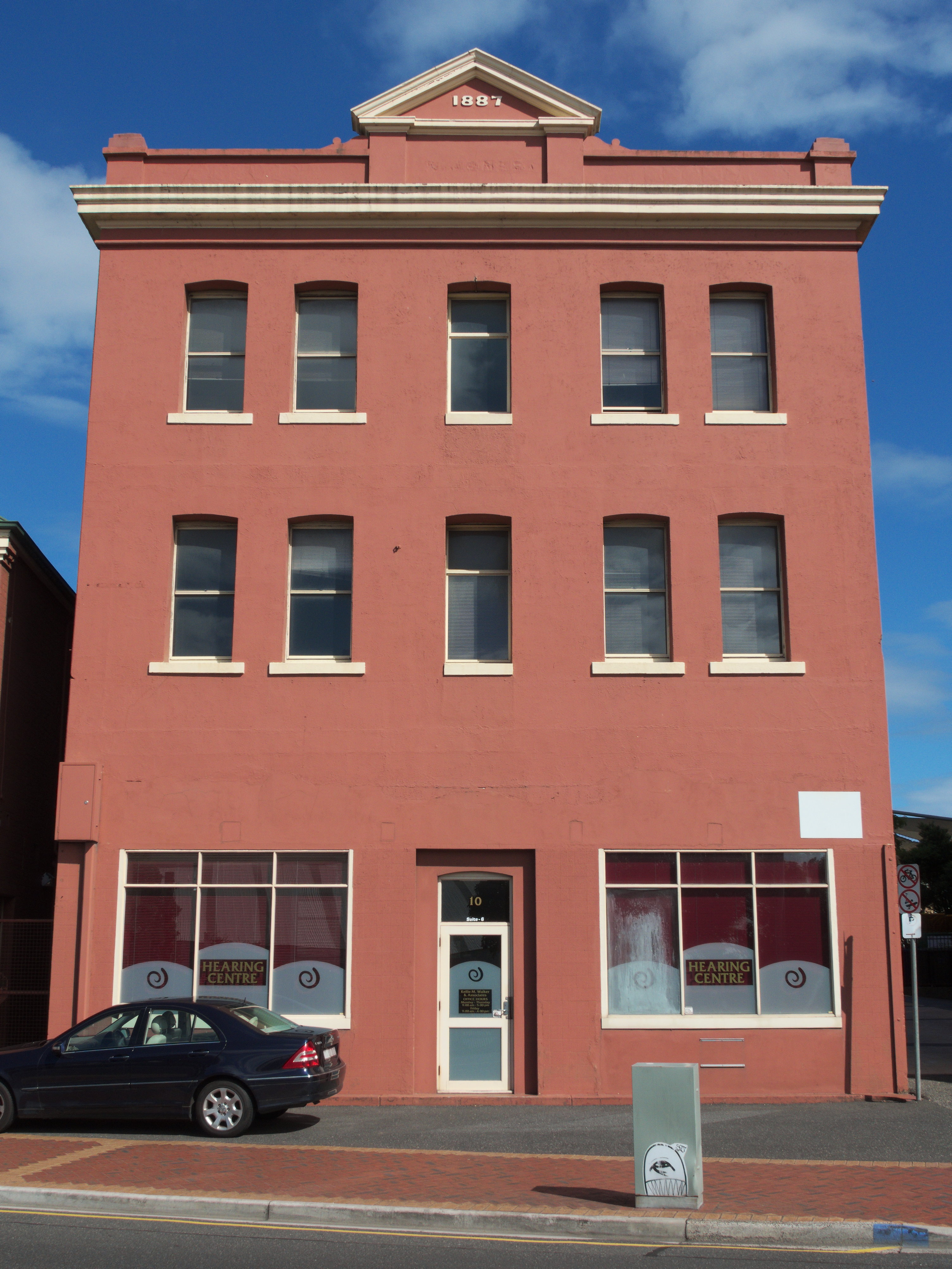 |
| 10 Marine Terrace, Burnie, Tasmania, was constructed in 1887 for William Jones, with the ground floor containing Jones' Auction Mart, the middle floor a skating rink, and the top floor hotel rooms associated with Thomas Wiseman's neighbouring Bay View Hotel. On 27 January 1896 it was gutted by the fire that destroyed the Bay View and Commercial hotels [2]. It was reconstructed in the same year to become the new Bay View Hotel, Gary Houston |
 |
| Burnie Memorial Lawn Cemetery, East Cam Road, Burnie, TAS |
 |
| Art-deco style office building at 39-41 Cattley Street, Burnie. It was apparently built as lawyers' offices, maybe in the 1930s. Gary Houston |
 |
| Art Deco apartments, Alexander St, Burnie, Tasmania, circa 1938 |
 |
| 69 Mount Street, Burnie, constructed as a cinema in the 1950s [1], known as the Star Theatre and perhaps later as Cinema One. It's now a bar and café; Otis Room and Run Rabbit Run. Gary Houston |
 |
| The Beach Hotel at 1 Wilson St, Burnie, Tasmania, on the corner with North Terrace. Originally the Sea View Hotel, it probably opened in late 1902 [1]. The first licensee was Joseph Thomas Alexander, who later built the Club Hotel which opened in 1912. Gary Houston |
 |
| At the Burnie heritage Museum, Burnie, TAS |
_(26123459246).jpg) |
| Gospel hall at 109 Wilson Street, Burnie, Tasmania. Michael Coghlan |
 |
| Building at Alexander Street, Burnie, was constructed as a Masonic temple and opened in 1923, Gary Houston |
 |
| Western District police adminstration and SES regional office, 88-98 Wilson Street, Burnie. A former house with Federation Filigree architecture. Gary Houston |
 |
| St George's Anglican Church at the corner of Mount Street and Cattley Street, Burnie. Brick building completed in 1885, Gary Houston |
 |
| The Hotel Regent on North Terrace, Burnie, Tasmania. It opened on 24 December, 1952. Gary Houston |
.jpg) |
| Wyona at 7 William Street, Burnie, originally on High Street. A Federation Queen Anne style house built circa 1914 for Edward Alfred Joyce. Michael Coghlan |
 |
| 9 Wilson Street on the corner with Wilmot Street. This art deco style building was constructed in 1940 by Carter & Peace for Mace and Wardlaw, Gary Houston |
 |
| Former Burnie High School Domestic Arts Building in Burnie, the last surviving building from the original Burnie High School site, opened in 1940. Gary Houston |
 |
| Former Advocate building in Mount Street, built 1920, Gary Houston |
 |
| J. T. Alexander’s magnificent Club Hotel built 1912 |
 |
| Burnie lawn Cemetery, East Cam Road, Burnie, TAS |
 |
| View of the port at Burnie, TAS |
 |
| This Art Deco style building was constructed in 1938 by Len Frith as the Vogue Theatre |
 |
| The former Post Office is an architecturally important example of Federation Free Classical architecture, located on Marine Terrace, built 1898 |
 |
| Cattley Street Burnie, TAS |
 |
| Victorian Georgian style of architecture, located on Marine Terrace, Burnie, TAS |
 |
| MM Smith of South Burnie constructed this buildings fronting Marine Terrace in a Post-War International Style of architecture, in 1956 |
Things To Do and Places To Go
The Art Deco Trail
Federation Walk
Pulp Paper Trail
Burnie Regional Museum
Convict Creations
Books To Read
The English Dane: From King of Iceland to Tasmanian Convict, By Sarah Bakewell






_(13415283495).jpg)
_(13415397133).jpg)











